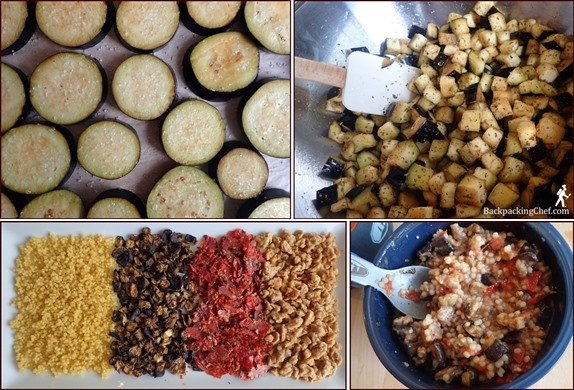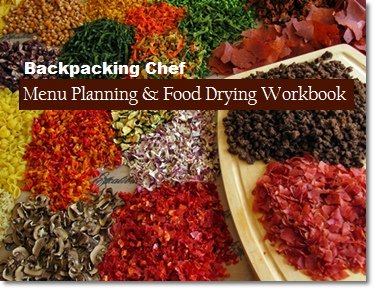Dehydrating Eggplant for Backpacking Meals
Eggplant
parmesan and ratatouille are just two of the trail meals you can make by
dehydrating eggplant. This page shows how to dehydrate eggplant after roasting
it in the oven, and how to cook eggplant on the stovetop before drying it.
Photos: (top) Salting the eggplant before cubing, seasoning, and roasting. (bottom) Dehydrated eggplant in eggplant parmesan.
Table of Contents
Cutting & Seasoning Eggplant
Ingredients: Salt, Italian seasoning mix, and garlic powder. No oil is used when dehydrating eggplant with this method.
The first step in dehydrating eggplant is applying salt to draw out some of the bitterness. If you enjoy the slightly bitter flavor notes of eggplant, you can skip the salting step.
Peeling the eggplant is optional. The skin contains nutritious flavonoids and antioxidants, so I leave it on.
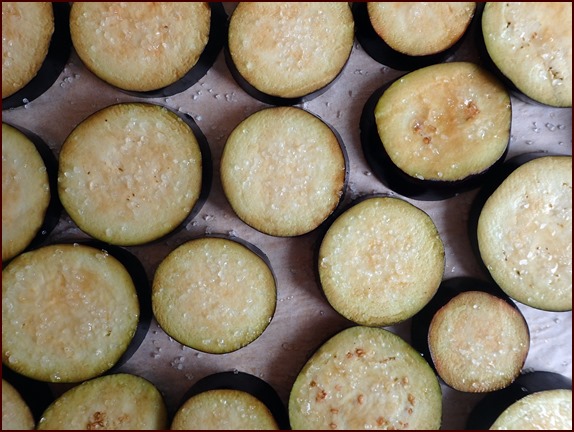
1. Cut eggplant crosswise into ½-inch slices.
2. Sprinkle a light coating of salt on both sides, and let the eggplant sit for 20 minutes. I use sea salt. You will observe moisture beading up on the flesh.
3. Rinse salt and brownish liquid off eggplant and pat dry with clean towels. If you don’t rinse, and only scrape off the salt with a spatula, the final product may be saltier than desired. (I tested it)
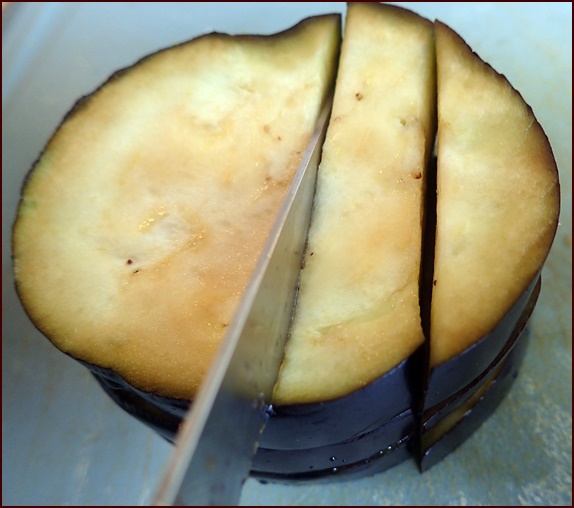
4. Stack the slices 3-high and cut down in ½-inch widths. Then turn the stack 90°, and cut down again in ½-inch widths, with the result being eggplant cubes approximately ½-inch square.
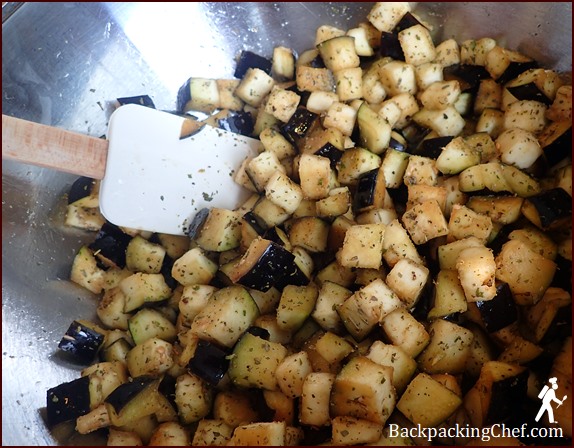
5. Place eggplant cubes in a bowl and add seasonings. For 3 small eggplants, 2 tablespoons of Italian seasoning and 1 teaspoon of garlic salt is good. Let sit while the oven heats up.
Oven Roasting Eggplant
Total baking time: 20–25 minutes.
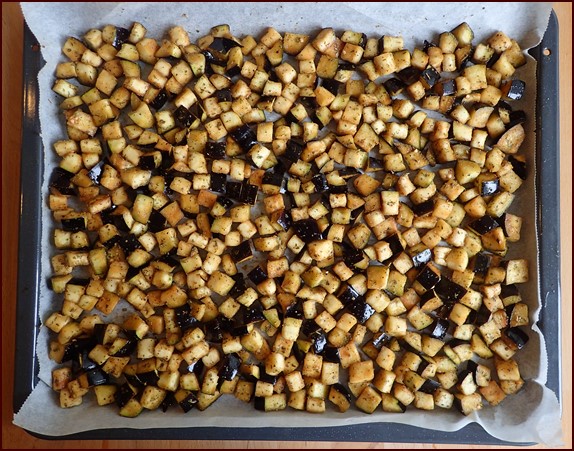
Photo: Seasoned eggplant cubes before roasting.
1. Preheat oven to 400°F (200°C)
2. Place eggplant cubes in a single layer on baking tray covered with parchment paper.
3. Bake 10–15 minutes on middle rack.
4. Remove tray from stove and stir eggplant cubes around.
Caution: A blast of steam may come out of the oven when you open it.
5. Place tray back in oven and continue baking 10 more minutes, but be prepared to take out sooner if the eggplant looks like it is close to burning.
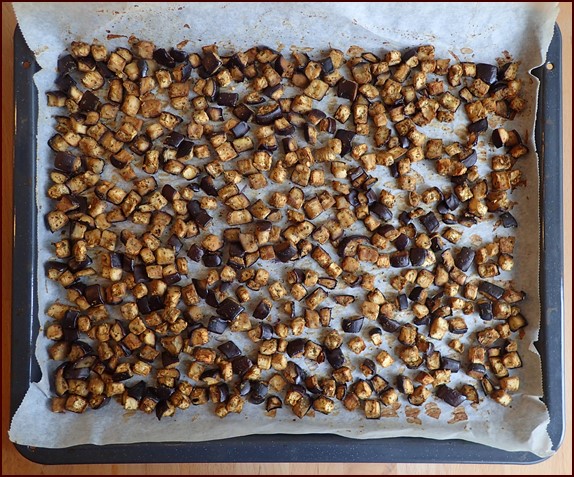
Photo: Eggplant cubes after roasting.
Dehydrating Eggplant
A lot of moisture evaporates from the eggplant during roasting. Before roasting, the eggplant cubes shown in the photos weighed 712 grams; after roasting they weighed 348 grams. This shortens the time needed for dehydrating eggplant.
Photo: Roasted eggplant on silicone mesh sheet. (Cosori dehydrator)
1. Place eggplant cubes on mesh dehydrator sheet in a single layer.
2. Dehydrate eggplant at 135°F (57°C) for approximately 8 hours.
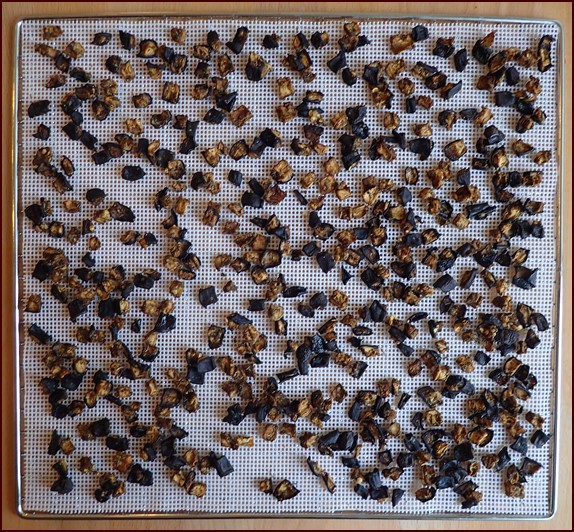
Photo: Dehydrated eggplant. It shrinks a lot.
Yield: 3 cups of roasted eggplant cubes weighing 347 grams yields 1 cup of dehydrated eggplant cubes weighing 72 grams.
Dehydrated eggplant will be dark in color, and compact. Some of the smaller pieces may seem like just skin. Eggplant softens back up to a nice chewy texture when you rehydrate it, but it doesn’t return to its original size.
Store dehydrated eggplant in an airtight container until ready to assemble meals.
Eggplant Parmesan Recipe
This recipe is an assembled meal that can be made with either chicken or chickpeas; both are good sources of protein. It can also be made with any type of precooked and dried pasta in place of pearl couscous. Just use the same weight as the pearl couscous. The pearl couscous gives this recipe a creamy texture, whereas macaroni will give it more bite.
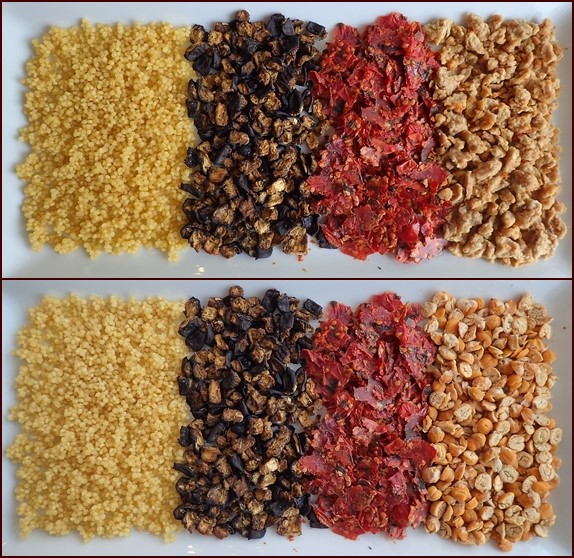
Photos: Dehydrated ingredients for eggplant parmesan.
Top: Pearl couscous, eggplant, stewed cherry tomatoes, and ground chicken.
Bottom: Pearl couscous, eggplant, stewed cherry tomatoes, and chickpeas.
Ingredients:
1 large serving
- ⅓ cup dried pearl couscous (40 g)
- ⅓ cup dried eggplant (25 g)
- ⅓ cup dried stewed tomatoes or tomato leather (16 g)
- ⅓ cup dried ground chicken or dried chickpeas (30 g)
- 1 Tbsp. olive oil (pack separately)
- 3 Tbsp. parmesan cheese (pack separately)
Water to Rehydrate:
- 1⅓ cups water if using ground chicken
- 1½ cups water if using chickpeas
Ingredient Help:
Dehydrating pearl couscous (Trail Bytes)
Photo: Stewed tomatoes with herbs on nonstick silicone dehydrator tray. You can also use tomato sauce leather in the recipes.
On the Trail:
I prepared both versions of the eggplant parmesan recipes by adding boiled water to the ingredients in separate GSI Outdoors bowls. Follow a similar procedure if cooking in the pot or in a freezer bag.
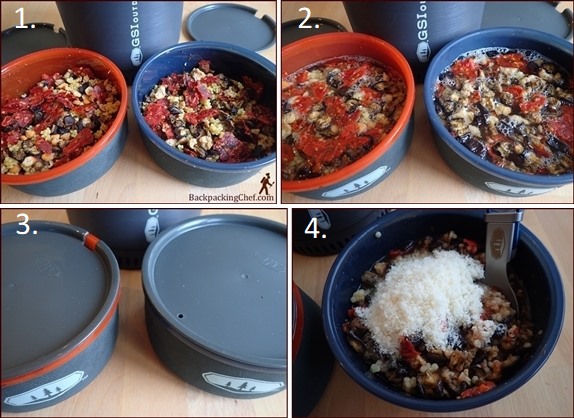
1. Place dried ingredients in bowl, holding back the olive oil and parmesan cheese.
2. Add boiled water and stir.
3. Cover bowl with lid and insulate. GSI bowls come with a lid and insulating sleeve. Wait 20–25 minutes until water is mostly absorbed by food.
4. Stir in olive oil and parmesan cheese. Buon appetito!
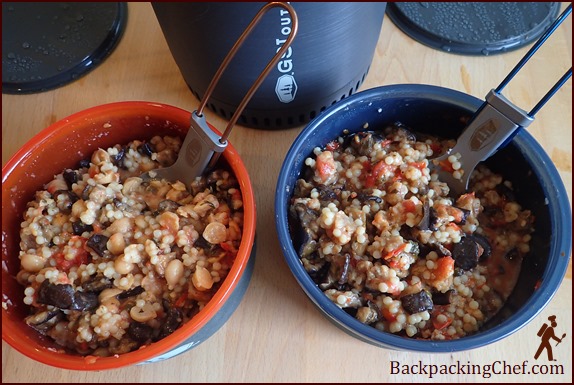
Photo: Eggplant parmesan with chickpeas on left, with chicken on right. Prepared and served in GSI Outdoors Dualist bowls.
Dehydrated Ratatouille Recipe
Another way of dehydrating eggplant is to cook it on the stove with other vegetables in ratatouille. It makes a nice meal all by itself, or you can combine it with rice or pasta.
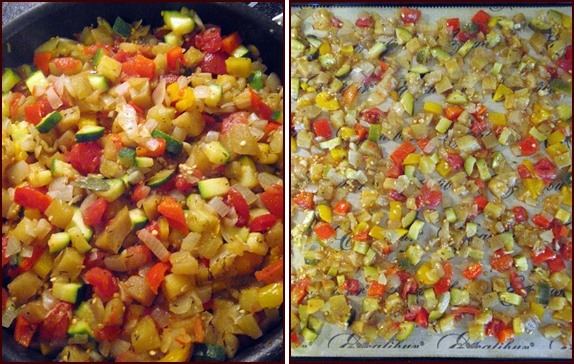
You’ll find the instructions and recipe on the Vegetarian Backpacking Meals page.
Explore: Making & Dehydrating Ratatouille.
Cosori Dehydrator & Accessories
Shop Amazon for the Cosori dehydrator and accessories used for dehydrating eggplant on this page. The silicone trays and silicone mesh sheets are flexible, truly nonstick, and are very easy to clean. Mesh sheets can be cut to size with scissors.

Left: Silicone Dehydrator Trays with Raised Edges, 11.8" x 10.8", 6-Pack
Middle: Cosori Dehydrator, Stainless Steel, 6-Trays
Right: Silicone Mesh Dehydrator Sheets, 14” x 14”, 12-Pack
Disclosure: As an Amazon Associate, Backpacking Chef earns from qualifying purchases. Thank you!
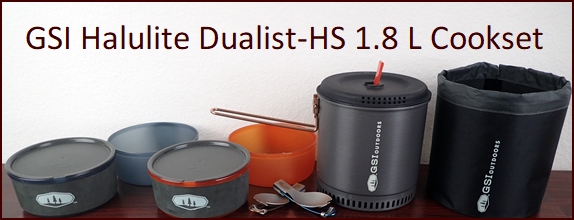
GSI Outdoors Halulite Dualist HS, 2-Person Backpacking Cookware Set.
Explore More…


Share this page with friends on social media.
Free E-book & Newsletter
Free with Trail Bytes subscription.
Dehydrating Food from A–Z

